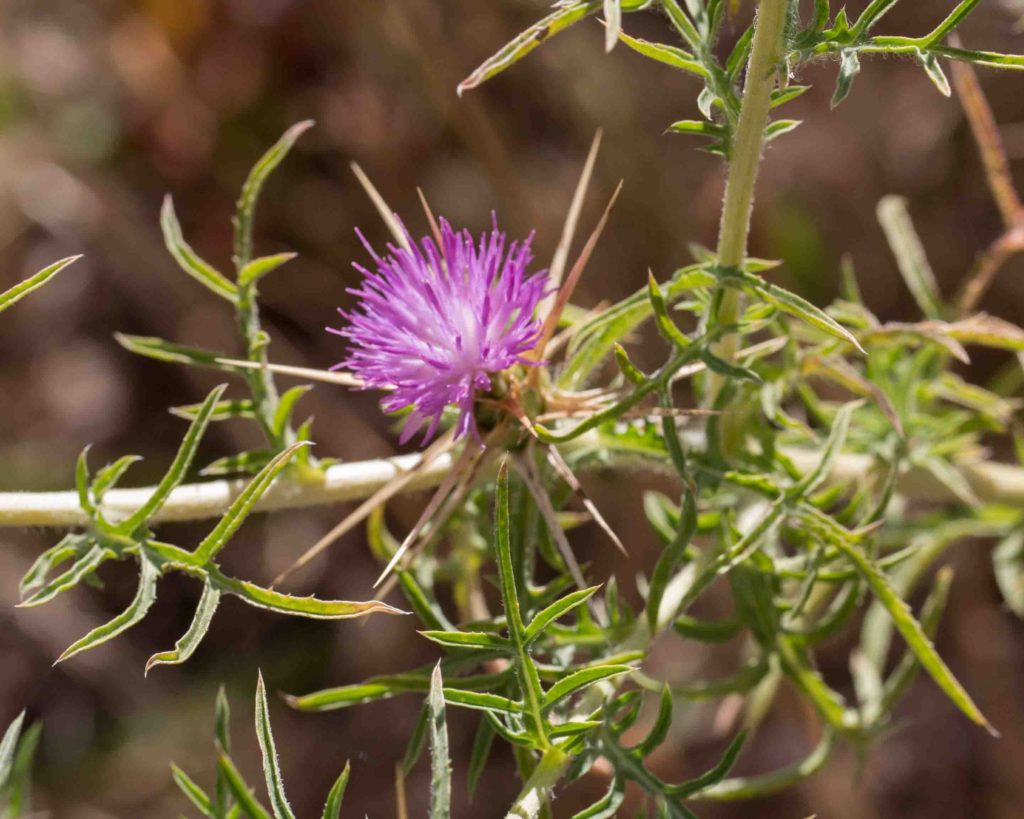Asteraceae: Sunflower Family – Cynareae (Thistle) Tribe: various (excl. Cirsium)
The Sunflower family is a very large family with over 25,000 members. Botanists subdivide the family into a number of tribes, of which 14 are present in Monterey County. The Cynareae (Thistle tribe) has 8 genera present in California, most of them alien. Many are invasive, including the ones found on this page.
Italian Thistle – Carduus pycnocephalus subsp. pycnocephalus
Blooms:
Mar–July
Plant Height:
0.2–2 m
Flower Size:
Medium
Origin:
Mediterranean
Invasive?
Yes – moderate
Habitat:
Roadsides, pastures, disturbed places
Notes:
Flower heads are fairly small (10–14 mm across) and in groups of 1–5, typically 3. Both leaves and stems are extremely prickly. Locally, this can be highly invasive and hard to eradicate.
Slender-flowered Thistle – Carduus tenuiflorus
Blooms:
Apr–June
Plant Height:
0.2–2 m
Flower Size:
Medium
Origin:
Mediterranean
Invasive?
Yes – limited
Habitat:
Roadsides, pastures, disturbed places
Notes:
The flowers are similar to those of Italian Thistle (Carduus pycnocephalus, see above), but are a paler shade of pink and are found in groups of 5–20. Both leaves and stems are extremely prickly. Locally, this can be highly invasive and hard to eradicate.
Blessed Thistle – Centaurea benedicta
Blooms:
Apr–June
Plant Height:
up to 1 m
Flower Size:
Medium
Origin:
Mediterranean
Habitat:
Disturbed places
Notes:
Low growing, with sprawling branches rising from the basal leaves. Flower heads are small, sessile or subsessile, and subtended by leaf-like bracts. The inner phyllaries are pinnately divided, with the divisions having spiny tips. The fruit has a straw-colored pappus with 2 series of unequal bristles.
Purple Star Thistle – Centaurea calcitrapa
Blooms:
Apr–Nov
Plant Height:
20–100 cm
Flower Size:
Medium
Origin:
Europe
Invasive?
Yes – moderate
Habitat:
Roadsides & waste places
Notes:
One of three invasive Star Thistles, this has pink-purple flowers borne on a head with long, sharp-spined phyllaries, 6–25 mm long.
.
Bachelor’s Button – Centaurea cyanus
Blooms:
Apr–Sept
Plant Height:
20–80 cm
Flower Size:
Medium
Origin:
Mediterranean
Habitat:
Roadsides, woodland & open areas
Notes:
A naturalized garden escapee, this is typically a rich blue, but may be found in pink or white. Leaves are loosely gray-tomentose, with linear to linear-lanceolate leaf blades with entire margins. Although this shares the same genus with the noxious and invasive Star Thistles, it could hardly look more different, bearing a much closer resemblance to the Knapweeds, which are so common in the plant’s native Europe.
Tocalote / Maltese Star Thistle – Centaurea melitensis
Blooms:
Apr–Aug
Plant Height:
10–100 cm
Flower Size:
Medium
Origin:
Southern Europe
Invasive?
Yes – moderate
Habitat:
Roadsides & waste places
Notes:
One of three invasive Star Thistles, this has yellow flowers borne on a head with dark purple, sharp-spined phyllaries. These are only 5–10 mm long, shorter than in Purple and Yellow Star Thistles (Centaurea calcitrapa & solstitialis, see entries this page). Leaves are short, soft and narrow, grayish-green in color.
.
Yellow Star Thistle – Centaurea solstitialis
Blooms:
May–Oct
Plant Height:
10–100 cm
Flower Size:
Medium
Origin:
Europe
Invasive?
Yes – high
Habitat:
Roadsides & waste places
Notes:
This is the most invasive of the Star Thistles. It has yellow flowers borne on a head with long, sharp-spined phyllaries, 10–20 mm long. When young, it can be grazed as a management tool, but as the season progresses the sharp spines make it inedible.
Milk Thistle – Silybum marianum
Blooms:
Feb–June
Plant Height:
0.2–3 m
Flower Size:
Large
Origin:
Mediterranean
Invasive?
Yes – limited
Habitat:
Dry, open places
Notes:
The large pinkish-purple flowers are immediately recognizable, as they are subtended by star-like phyllaries with long, sharp spines radiating out from the base of the flower head. Equally distinctive are the large, white-veined leaves. Although in the “limited” category of invasiveness, it can be highly invasive locally and can take over extensive areas. Photo #2 by CJH.




























